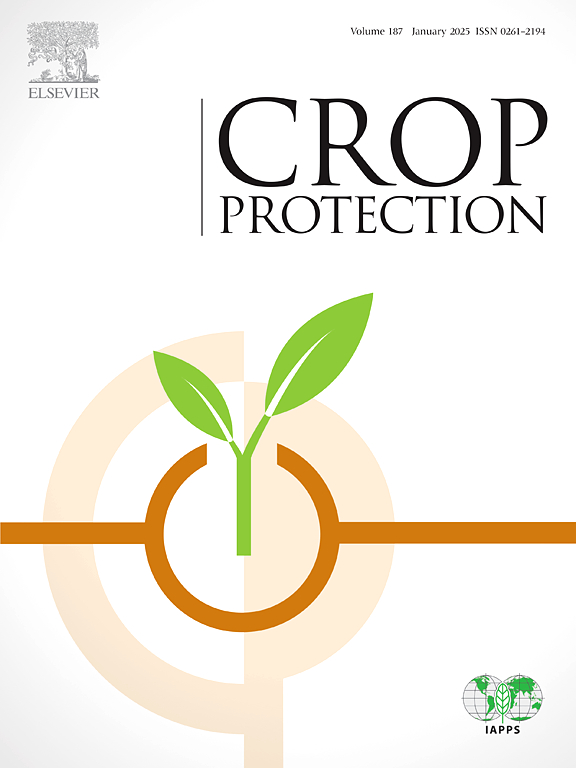印度玉米花后茎腐病新病原菌木霉
IF 2.5
2区 农林科学
Q1 AGRONOMY
引用次数: 0
摘要
本研究探讨了木霉物种作为玉米茎腐病病原体的作用,代表了印度第一个有记录的病例。从不同地区采集的侵染玉米秸秆中分离得到三种不同的木霉菌株(HSRT46、HSRT47和HSRT67),它们在菌落颜色、菌丝类型、色素沉着和分生孢子结构等形态特征上存在差异。采用牙签接种法进行的致病性测定证实了分离株的毒力,病灶长度为5 ~ 9 cm,以HSRT46记录最高。利用ITS-rDNA和TEF-1α测序对分离株进行分子鉴定,鉴定菌株为非froharzianum (HSRT46)和T. harzianum (HSRT47和HSRT67)。系统发育分析表明木霉与atrobrunneum关系密切,这一发现揭示了木霉的双重作用,传统上以其生物防治能力而闻名,在有利的环境条件下可能作为机会致病菌。这强调需要持续监测玉米中的木霉种群,特别是在雨养地区,以减轻对作物健康和产量的潜在影响。未来的研究应该旨在确定导致木霉从共生角色转变为致病角色的条件,从而支持印度可持续玉米生产的有效疾病管理策略的发展。本文章由计算机程序翻译,如有差异,请以英文原文为准。
Trichoderma spp. as a novel pathogen for maize post-flowering stalk rot in India
This study explores the role of Trichoderma species as causative agents of stalk rot in maize, representing the first documented case in India. The pathogens were isolated from the infected maize stalks collected from various regions, revealing three distinct Trichoderma isolates (HSRT46, HSRT47 and HSRT67), which exhibited variability in morphological traits such as colony color, mycelium type, pigmentation and conidial structures. Pathogenicity assays, conducted using the toothpick inoculation method, confirmed the virulence of the isolates, with lesion lengths ranging from 5 cm to 9 cm, with HSRT46 having the highest record. Molecular characterization using ITS-rDNA and TEF-1α sequencing identified the isolates as Trichoderma afroharzianum (HSRT46) and T. harzianum (HSRT47 and HSRT67). Phylogenetic analysis signified a close relationship with T. atrobrunneum and this finding revealed a dual role for Trichoderma, traditionally known for its biocontrol capabilities, which may act as opportunistic pathogens under favorable environmental conditions. This emphasizes the need for ongoing monitoring of Trichoderma populations in maize, particularly in rain-fed regions, to mitigate the potential impacts on crop health and yield. Future research should aim to identify the conditions that cause Trichoderma to transition from a symbiotic to a pathogenic role, thus supporting the development of effective disease management strategies for sustainable maize production in India.
求助全文
通过发布文献求助,成功后即可免费获取论文全文。
去求助
来源期刊

Crop Protection
农林科学-农艺学
CiteScore
6.10
自引率
3.60%
发文量
200
审稿时长
29 days
期刊介绍:
The Editors of Crop Protection especially welcome papers describing an interdisciplinary approach showing how different control strategies can be integrated into practical pest management programs, covering high and low input agricultural systems worldwide. Crop Protection particularly emphasizes the practical aspects of control in the field and for protected crops, and includes work which may lead in the near future to more effective control. The journal does not duplicate the many existing excellent biological science journals, which deal mainly with the more fundamental aspects of plant pathology, applied zoology and weed science. Crop Protection covers all practical aspects of pest, disease and weed control, including the following topics:
-Abiotic damage-
Agronomic control methods-
Assessment of pest and disease damage-
Molecular methods for the detection and assessment of pests and diseases-
Biological control-
Biorational pesticides-
Control of animal pests of world crops-
Control of diseases of crop plants caused by microorganisms-
Control of weeds and integrated management-
Economic considerations-
Effects of plant growth regulators-
Environmental benefits of reduced pesticide use-
Environmental effects of pesticides-
Epidemiology of pests and diseases in relation to control-
GM Crops, and genetic engineering applications-
Importance and control of postharvest crop losses-
Integrated control-
Interrelationships and compatibility among different control strategies-
Invasive species as they relate to implications for crop protection-
Pesticide application methods-
Pest management-
Phytobiomes for pest and disease control-
Resistance management-
Sampling and monitoring schemes for diseases, nematodes, pests and weeds.
 求助内容:
求助内容: 应助结果提醒方式:
应助结果提醒方式:


